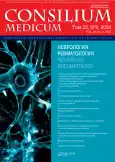Российский опыт применения идаруцизумаба для нейтрализации антикоагулянтного эффекта дабигатрана перед проведением тромболитической терапии пациентам с ишемическим инсультом
- Авторы: Домашенко М.А.1, Лоскутников М.А.1
-
Учреждения:
- АНО «Центральная клиническая медико-санитарная часть»
- Выпуск: Том 22, № 9 (2020)
- Страницы: 52-56
- Раздел: Статьи
- URL: https://journals.rcsi.science/2075-1753/article/view/95361
- DOI: https://doi.org/10.26442/20751753.2020.9.200474
- ID: 95361
Цитировать
Полный текст
Аннотация
Ключевые слова
Полный текст
Открыть статью на сайте журналаОб авторах
Максим Алексеевич Домашенко
АНО «Центральная клиническая медико-санитарная часть»
Email: mdomashenko@gmail.com
канд. мед. наук, невролог, глав. врач Магнитогорск, Россия
Марк Алексеевич Лоскутников
АНО «Центральная клиническая медико-санитарная часть»канд. мед. наук, невролог, рук. регионального сосудистого центра Магнитогорск, Россия
Список литературы
- Otite FO, Khandelwal P, Chaturvedi S et al. Increasing atrial fibrillation prevalence in acute ischemic stroke and TIA. Neurology 2016; 87 (19): 2034-42.
- Connolly SJ, Ezekowitz MD, Yusuf S et al. Dabigatran versus warfarin in patients with atrial fibrillation. N Engl J Med 2009; 361 (12): 1139-51.
- Patel MR, Mahaffey KW, Garg J et al. Rivaroxaban versus warfarin in nonvalvular atrial fibrillation. N Engl J Med 2011; 365 (10): 883-91.
- Granger CB, Alexander JH, McMurray JJ et al. Apixaban versus warfarin in patients with atrial fibrillation. N Engl J Med 2011; 365 (11): 981-92.
- Giugliano RP, Ruff CT, Braunwald E et al. Edoxaban versus warfarin in patients with atrial fibrillation. N Engl J Med 2013; 369 (22): 2093-104.
- Mitchell A, Watson MC, Welsh T et al. Effectiveness and Safety of Direct Oral Anticoagulants versus Vitamin K Antagonists for People Aged 75 Years and over with Atrial Fibrillation: A Systematic Review and Meta-Analyses of Observational Studies. J Clin Med 2019; 8: E554.
- Alberts MJ, Eikelboom JW, Hankey GJ. Antithrombotic therapy for stroke prevention in non-valvular atrial fibrillation. Lancet Neurol 2012; 11 (12): 1066-81.
- Seiffge DJ, Hooff RJ, Nolte CH et al. Recanalization therapies in acute ischemic stroke patients: impact of prior treatment with novel oral anticoagulants on bleeding complications and outcome. Circulation 2015; 132 (13): 1261-9.
- Hankey GJ, Norrving B, Hacke W, Steiner T. Management of acute stroke in patients taking novel oral anticoagulants. Int J Stroke 2014; 9 (5): 627-32.
- Heidbuchel H, Verhamme P, Alings M et al. European Heart Rhythm Association. European Heart Rhythm Association practical guide on the use of new oral anticoagulants in patients with non-valvular atrial fibrillation. Europace 2013; 15 (5): 625-51.
- Diener HC, Foerch C, Riess H et al. Treatment of acute ischaemic stroke with thrombolysis or thrombectomy in patients receiving anti-thrombotic treatment. Lancet Neurol 2013; 12 (7): 677-88.
- Kate M, Szkotak A, Witt A et al. Proposed approach to thrombolysis in dabigatran-treated patients presenting with ischemic stroke. J Stroke Cerebrovasc Dis 2014; 23 (6): 1351-5.
- Pollack CV Jr, Reilly PA, Eikelboom J et al. Idarucizumab for dabigatran reversal. N Engl J Med 2015; 373 (6): 511-20.
- Shahjouei S, Tsivgoulis G, Bavarsad Shahripour R et al. Safety of intravenous thrombolysis among stroke patients taking new oral anticoagulants: case series and systematic review of reported cases. J Stroke Cerebrovasc Dis 2015; 24 (12): 2685-93.
- Pikija S, Sztriha LK, Mutzenbach JS et al. Idarucizumab in Dabigatran-Treated Patients with Acute Ischemic Stroke Receiving Alteplase: A Systematic Review of the Available Evidence. CNS Drugs 2017; 31 (9): 747-57.
- Kermer P, Eschenfelder CC, Diener HC et al. Antagonizing dabigatran by idarucizumab in cases of ischemic stroke or intracranial hemorrhage in Germany - Updated series of 120 cases. Int J Stroke 2020; 15 (6): 609-18.
- Реперфузионная терапия ишемического инсульта. Клинический протокол. М., 2019.
- Lip GY, Clemens A, Noack H et al. Patient outcomes using the European label for dabigatran. A post-hoc analysis from the RE-LY database. Thromb Haemost 2014; 111: 933-42.
- Пудов Е.В., Сухачева Н.Н., Петелина И.С. Первый опыт тромболитической терапии инфаркта мозга в Российской Федерации после применения идаруцизумаба. Неврология, нейропсихиатрия, психосоматика. 2020; 12 (1): 68-71.
Дополнительные файлы





